I really like your explanations of your ratings and this release quite sure is the best one of this recording! But especially for vintage rock or jazz, a third rating for absolute sound quality could be meaningful. Otherwise some might wonder why a record with an 11 sound quality rating can pracilcally sound quite bad compared to today's or past's higher standards and just sounds like an 11 considering that any other release of it sounds even worse. So finally we find examples for any rating, while having the same one, sounding day and nigh different in absolute sound quality. This is not necessarily a very helpful side effect of a "sound rating".
The Doors’ L.A. Woman Puts You Right in the Band’s Rehearsal Room on Acoustic Sounds’ Stunning New 200g 1LP UHQR Edition
In honor of Audiophile Day (October 2), I spent the balance of my afternoon and evening hours spinning some of my favorite LPs, both new and old alike. Ahh, the ongoing aural wonders of that sweet, sweet vinyl science! Anyway, with all that in mind, I now want to get into one of my favorite repeat listens of the day — so let me tell you a story about The Doors and the big beat of Analogue Productions’ new 200g 1LP UHQR edition of their April 1971 studio swan song on Elektra with Jim Morrison behind the mike during his lifetime, L.A. Woman.
I will delve into the sound of the new L.A. Woman LP shortly, but the gist of it all is simply this: If you want to spin primo late-period Doors on just one 200g Clarity Vinyl LP as only Acoustic Sounds and Quality Record Pressings (QRP) can deliver it with their unmatched UHQR (Ultra High Quality Record) series, then this is the version to get.
The stats are these. The UHQR edition of L.A. Woman was mastered by Bernie Grundman at Bernie Grundman Mastering from the original analog master tapes, plated by Stan Bishop and pressed at QRP using Clarity Vinyl, and it is limited to 4,500 copies. The release already seems to have struck a chord with the buying and listening public since, as of this posting, this version of L.A. Woman is currently nestled at No. 1 on Acoustic Sounds’ UHQR Top Seller chart.
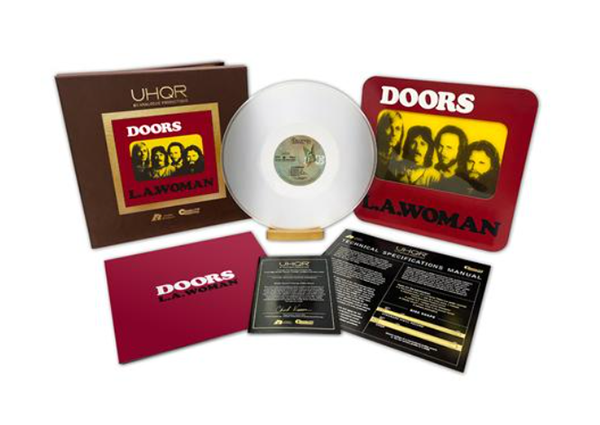
As to the iconic album artwork, the curved-edge L.A. Woman jacket has been die-cut direct-to-board to match that of the original release, and it is housed inside the UHQR box itself for whatever purpose you see fit, alongside the usual top-flight UHQR accoutrements (i.e., a UHQR Signature Sheet, UHQR Technical Specs Manual, an audiophile-grade inner sleeve, and a protective plastic sleeve). However, the box’s own outer shell does not exactly match the full dowel spine/slipcase presentation native to the balance of UHQR releases we’ve seen, mainly due to the time factor it would have taken QRP to manufacture it that way — which, of course, would have further delayed its entry into the marketplace.
An 8-page saddle-stitched booklet includes a full B&W spread shot of The Doors and producer Bruce Botnick together around a table in their rehearsal space-cum-studio dubbed The Doors Workshop in Los Angeles; liner notes and a reproduction of “The Last Interview” with Morrison by onetime Rolling Stone scribe Ben Fong-Torres; and a beautiful full-page shot of the original Artisan Sound Recorders 2-track 15ips tape box. I won’t spoil it, but the Morrison interview, billed (as noted) as the man’s “last,” having been conducted five months before his untimely passing in Paris in July 1971, is brief and to the point, somewhat chilling by nature, and quite preternatural.
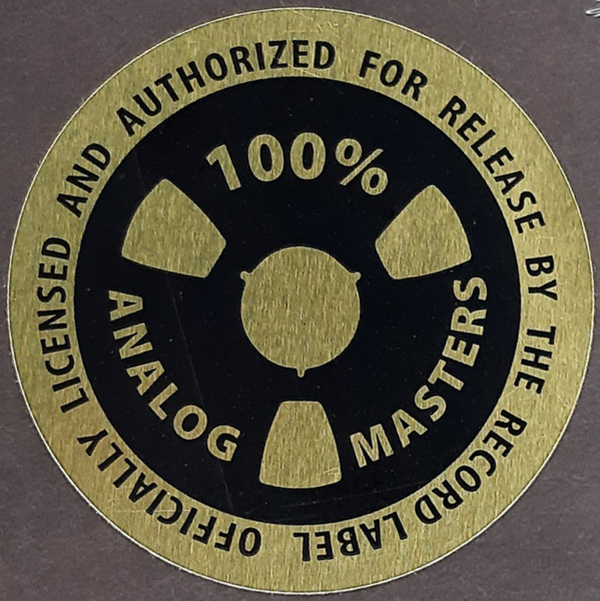
To be fair, many discerning listeners — me included — absolutely love the sound of the years-earlier 180g 2LP 45rpm edition of L.A. Woman that was mastered by Doug Sax, overseen by Bruce Botnick, and released by Analogue Productions. But, as label head honcho Chad Kassem told me on the phone recently, they didn’t want to replicate what Sax had done with that edition here, so they turned to Grundman to master the new single LP release — and you will indeed hear certain, albeit minute, differences in terms of that unmistakable in-the-room feel, of which both versions do admittedly get across quite expertly. In both cases, the low end is low, the mids are right where they belong, and the highs are high (pun not intended). That said, some have felt Morrison’s vocals are more, shall we say, “ethereal” on the 45rpm version and the bass is also a bit restrained, and I can discern all that at the nitpicky level of things — none of which deters my listening enjoyment, mind you.
So, is it ultimately a case of apples vs. oranges, and/or winner takes all? Well, what your obtainment decision may ultimately boil down to are the combined factors of a) price, b) the (in)convenience of whether you want to get up and flip two LPs/four sides for your L.A. Woman listening session(s) or just turn over 1LP for two sides and the more natural flow of the album’s original intention, c) whether you have a preference for 33⅓ or 45rpm playback given the amount of music and information per side and your philosophies about any related sonic differences therein, d) if you prefer Sax mastering to Grundman mastering, and/or e) if you’re a Doors (and/or UHQR) completist and absolutely must have everything that is released with their name at the top of the LP marquee, as it were.
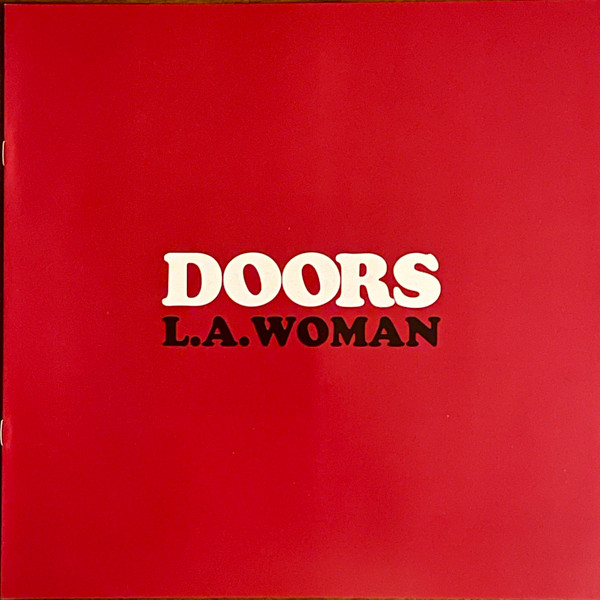
Speaking of the entry fee, the SRP for the new UHQR edition of L.A. Woman is $125, and you can order it either directly from Acoustic Sounds here, or via Music Direct via this link, or from MD via the link graphic at the end of this review. In comparison, the 2LP Sax set lists for $60 — but be mindful that a) that edition is not a UHQR, b) it’s 180g not 200g, and c) it’s currently on back order at Acoustic Sounds anyway, so you’d actually have to go elsewhere and pony up anywhere from $75 to $150 on up, depending on the condition you want it in, not to mention the added shipping cost.
One last thing to note before I get into the UHQR song by song. If you have an original Artisan Sound Recorders version of the album (the Pitman pressing, that is), then you know how good L.A. Woman is meant to sound on vinyl. I’ve picked up subsequent pressings over the years that could never quite match it, but the 2LP 45rpm edition took that crown once it arrived (nitpicks be damned). And, to satisfy my completist’s itch, I’ve also quite enjoyed playing Elektra/Rhino’s
First, recall those earlier comments re my broader assessment of the overall lows, mids, and highs. My copy was well-centered (if a big snug on the spindle) and dead-quiet. On Side One of the UHQR, “The Changeling” (Track 1) sets the table for Morrison’s mostly guttural vocal tone throughout the album (and key on how he phrases “uptown” and “I had none”), and where keyboardist Ray Manzarek and his Hammond organ reside off to the right. A differing vocal effect shifts Morrison’s approach on “Love Her Madly” (Track 2), but take note of guitarist Robby Krieger’s clever comps way off to the left and a bit back in the mix behind Manzarek’s Vox Continental solo in the right later in the track. The blues-bending “Been Down So Long” (Track 3) — sorry, I meant to say, “Been Down So Goddamn Long” — is anchored down the middle by Jerry Scheff’s boss bass line (yes, Scheff!) (sorry, had to go there!) while Krieger’s sinewy slide guitar soloing takes over in the right. “Cars Hiss by My Window” (Track 4) slows the bluesy proceedings down even further, and I continue to marvel at drummer John Densmore’s snare and the natural reverb off it — not to mention Morrison’s hornlike vocal-comp mouth solo toward the end, if you will. Finally, “L.A. Woman” (Track 5) revs back into high gear to end the side beautifully, with Manzarek’s ramble-tamble Rhodes piano setting the city-at-night table before giving way to Krieger’s highway-stretching back-half soloing.
And then there’s Side Two. “L’America” (Track 1) unfolds not unlike a just-as-creepy cousin to “Not to Touch the Earth” (from July 1968’s Waiting for the Sun, on Elektra), with Krieger’s opening doom riff rolling from right to left as the rest of the band soon enough falls in, accented by Densmore’s insistent militaristic drums. At first, the vibe of “Hyacinth House” (Track 2) appears to be sunnier on the surface, before Morrison’s measured, hold-it-together-man vocal underscores a clear cry for help as buttressed by Manzarek’s burbling-under-the-surface Hammond organ riffs over to the right, until Jim buttons it up with a somewhat terse plea, “And I’ll say it again / I need a brand new friend / The end.” Next up, the hardcore blues return with a searing cover of John Lee Hooker’s “Crawling King Snake” (Track 3), a.k.a. “I Am the Original Lizard King,” buoyed by Densmore’s cymbal and hi-hat work and Krieger’s sneering riffs off to the right. Everyone eats in “The WASP (Texas Radio and the Big Beat)” (Track 4), a jazzy soundtrack backing for Morrison’s wide-panned poetic-reading precursor to the November 1978 spoken-word-oriented Doors album on Elektra, An American Prayer, anchored here by Scheff’s super-fat thumping bass and Densmore’s supple swing. “Riders on the Storm” (Track 5) closes it all so beautifully, and oh-so-sublimely — certainly to this day one of my absolute favorite Doors tracks — led by Morrison’s doubled vocals (his ghostly whispered backing vox perhaps being one of the earliest examples of ASMR!), Manzarek’s light-touch rain-tinkling Rhodes piano, Densmore’s superb stickwork, and Krieger’s decaying delay-laden guitar riffs.
And now, to the ratings. The Music is an easy 10. It’s a perfect bookend to The Doors’ self-titled January 1967 debut LP on Elektra, which is a stone-cold, non-negotiable 11. The Sound rating goes like this, in order of direct comparison — a clean Artisan Sound Recorders Pitman pressing original is a 10 (an original is an original is an original), the 2LP 45rpm edition is a 10.5 (with only 0.5 off a perfect score for its side-flipping semantics and general interruption of the musical flow), and the new UHQR L.A. Woman gets a vaunted 11, because it delivers all the promise, power, murder, and madness of The Doors’ collective blood, sweat, and intent.
I’ve played this new 1LP edition dozens of times since I first got it in hand, and it has yet to fatigue me, bore me, or let my mind wander as it plays. That’s the mark of a great recording rendered even greater as a listening experience that I’ll doubtless return to again and again. In short, don’t let The Doors’ UHQR L.A. Woman hiss by your purchasing window. It’s got that undeniable risin’ mojo, mr., of an LP that is truly heavenly in its brilliance.
THE DOORS
Side One
Side Two

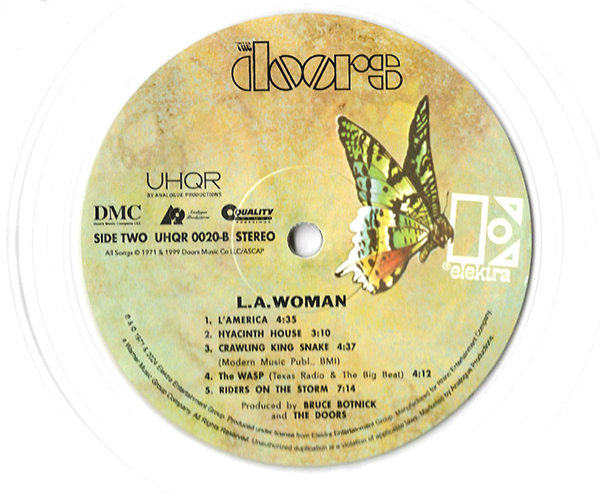

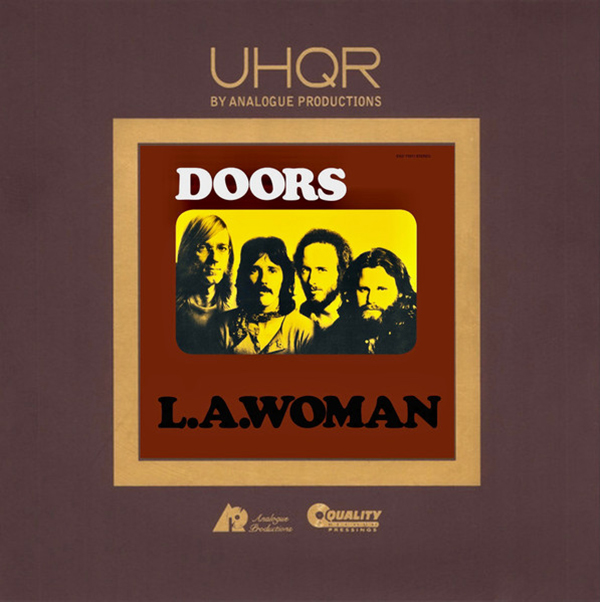
L.A. WOMAN
200g 1LP (Elektra/Analogue Productions)
1. The Changeling
2. Love Her Madly
3. Been Down So Long
4. Cars Hiss By My Window
5. L.A. Woman
1. L’America
2. Hyacinth House
3. Crawling King Snake
4. The WASP (Texas Radio And The Big Beat)
5. Riders On The Storm

- Log in or register to post comments


So, 0.5 of a mark deducted because or having to flip sides twice as many times but no mention of the oft lorded sonic superiority of the 45rpm format. You can’t have it both ways. Oh, and this new one is over twice the price. I’ll stick thank you. FTR I have 2 UHQRs so I’m not anti them

An OK Boomer here who love the Doors.
I think my AP 45rpm is a fantastic spin and going to pass on this one but I would love to sit in front of it and compare.
Great album and bet anyone scoring one will be a happy camper.
Happy Spinning

After hearing Fremer mention it a while back, I really believe that 45rpm have a direct-drive-like flow that 33.3rpm pressings only can match with $10K plus turntable systems.
Yes, it is a pain and does break the immersion, but you are old/fat/lazy and really need to get up more. Lol. (Not directed at the author but we audiophiles generally.)

Is a MUST for any Doors lover. While I am a completist and I am tempted to get this as well, I have the 45 and I need to be sane about all of the purchases I intend to make for the next few months. The box set is unreal SQ (for the era, etc.)
With so many must-have titles hitting each month, this takes a pass. The Smile 'Cutouts' hits today as well as getting Ragged Glory for an exorbitant price of $50 for what I expect to be a 140gm pressing.
(Neil can totally suck it these days... Bailing on the Chicago show this summer an hour before the concert was unforgivable and his latest 'Takes' was so warped I am becoming jaded on all things Neil. Def passing on his money grab 'OTB 50'.)

I listened to just the new stuff yesterday- from interstate onward. Spook the Horse was fun and does sound quite good. I need to do a shootout of Interstate for sure. It DOES sound better, but I need to gauge how much. I was expecting more, but it's way too early. No warping I can tell on LP 3.
I also got Takes as well. And I do like it quite a bit. The whole first LP is warped to f***. THAT pissed me off, but I have a clamp and extra wide washers to compensate for the most part. LP1 on Takes is fine and the SQ is solid across the board- VASTLY better than the original bootlegs. (I own them all- His 4CD bootleg box set that was hot in the 90's is really the blueprint for all of the archives- But alas the archives are VASTLY deeper.
I'll probably pass on OTB 50 unless he has additional songs like Ragged Glory.

where I lusted after Weld and ARC on LP... those days are loooong gone. I have the CD's and with a great DAC comes compromise. Hearing that show at the Target Center in Minneapolis was an exercise in extreme auditory torture. 'Not made for sound' venue turns into an echo chamber of death! I literally had to take breaks from the event, even with earplugs. All basketball arenas back then sucked utterly for sound. Peter Gabriel's last tour at the Fiserv Forum made me consider the 'now' is different.
BUT, when it comes to Ragged Glory remaster... It's better across the board. After listening to matched levels across the original and the remastered, there is no comparison. The soundstages created, the snare drum reverb, the correct tone of the drums with larger decay, which affects width and depth perspective is all improved substantially (as in not subtle). Bass is improved to, but it's not messed with in any mix way, like a smile curve. It is also substantially louder over the original vinyl.
On 'Fuckin Up' the whole sensation of the back wall acoustic is much more enveloping, yet still rocks the way it needs to. That snare is fundamentally right where before it was always a little off to the unavoidable bright side of this recorded era. The liveliness of this song was not increased or hyped in any way to get at more detail. Just a more relaxed song of the three and easier to hear into the acoustic vs. 'Country Home' and 'White Line' (as those have a lot of percussion going on throughout and loud guitar solos).
I listened 'Interstate' pretty quietly last time and a new matched level comparison today. While subtle as one is listening to 3 acoustic guitars here, the center image is the key again with greater relief from the backing vocals as well as the guitar twang brightness is reduced. It can be sharp on the original during sharp picking, but the remaster misses this entirely. The rest of the sound is there, just without the excessive ringing. This song on either LP appears to have the same volume levels. (off of Broken Arrow Vinyl only release for the original).
Yeah Mike, you need the new Ragged Glory LP. Enjoy.
Also, please check out this killer website of a person who is now hanging it up for a life in France, yet has such immense talent over her 600 reviews of smart, artistically critical music. She needs an archivist and I really think Analog Planet would be brilliant if it was doable. I told her to reach out to Tracking Angle previously, but perhaps you are also a great fit?
This really is too good to let disappear into the ether! https://altrockchick.com/2024/10/26/ai-resistance-via-live-at-the-bbc/
Probably her final post.

All my favorite cuts run toward the inner grooves.
This LP screams out for linear tracking arms.

The record is quite long (48'25), only Irrlicht by the late K. Schulze comes to mind as an example of an even longer record with side 1 at 29' (there were compilations at 60' and more during the 1970s).
So the double 45 is essential to obtain more dynamics and solve the problem of the ends of sides and the engraving level. Unless you have a Linn of the time (another glorious idea than the single-speed turntable but it can be adapted). And not only for this record. I also noticed less scratching on these 45 rpm maxis.

Mike Mettler reviews the new 200g UHQR edition of The Doors' "L.A. Woman," praising its sound quality and packaging. Mastered by Bernie Grundman, it offers a unique listening experience, with detailed instrumentation and Morrison's haunting vocals, making it a must-have for audiophiles.
tag game





